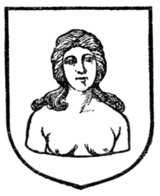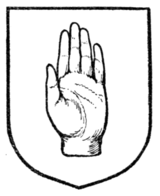under a veil or canopy azure, garnished or, in base a thistle vert"] are worthy of quotation.
The boy's head will seldom be found except in Welsh coats, of which the arms of Vaughan and Price are examples.
Another case in which the heads of children appear are the arms of Fauntleroy ["Gules, three infants' heads couped at the shoulders proper, crined or"], which are a very telling instance of a canting device upon the original form of the name, which was "Enfantleroy."
Children, it may be here noted, are seldom met with in armory, but instances will be found in the arms of Davies, of Marsh, co. Salop ["Sable, a goat argent, attired or, standing on a child proper swaddled gules, and feeding on a tree vert"], of the Foundling Hospital ["Per fesse azure and vert, in chief a crescent argent, between two mullets of six points or, in base an infant exposed, stretching out its arms for help proper"], and in the familiar "bird and bantling" crest of Stanley, Earls of Derby. Arms and hands are constantly met with, and have certain terms of their own. A hand should be stated to be either dexter (Fig. 257), or sinister (Fig. 258), and is usually blazoned and always understood to be couped at the wrist. If the hand is open and the palm visible it is "apaumé" (Figs. 257 and 258), but this being by far the most usual position in which the hand is met with, unless represented to be holding anything, the term "apaumé" is not often used in blazon, that position being presumed unless anything contrary is stated.
 Fig. 256.—A woman's head and bust. |
 Fig. 257.—A dexter hand. |
 Fig. 258.—A sinister hand. |
The hand is occasionally represented "clenched," as in the arms and crest of Fraser-Mackintosh. When the thumb and first two fingers are raised, they are said to be "raised in benediction" (Fig. 259).
The cubit arm (Fig. 260), should be carefully distinguished from the arm couped at the elbow (Fig. 261). The former includes only about two-thirds of the entire arm from the elbow. The form "couped at the elbow" is not frequently met with.
When the whole arm from the shoulder is used, it is always bent at
